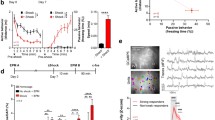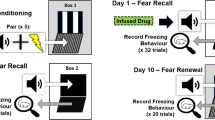Abstract
Rationale
Several lines of recent evidence suggest that endocannabinoids affect behavior by influencing the general patterns of challenge responding.
Objectives
Here, we investigated the brain mechanisms underlying this phenomenon in rats.
Methods
The anandamide hydrolysis inhibitor URB597 was condensed into the tip of stainless steel cannulae, which were chronically implanted slightly above the prelimbic cortex (PRL) or the basolateral amygdala (BLA), two important regions of coping and endocannabinoid action. Thereafter, we investigated behavioral responsiveness to ambient light level in the elevated plus-maze and conditioned fear tests.
Results
URB597 concentration was ~30 μg/mg protein in target areas; local brain anandamide levels increased threefold, without significant changes in 2-arachidonoylglycerol. High levels of illumination halved the time spent by controls in the open arms of the plus-maze. No similar decrease was observed in rats with URB597 implants in the PRL. High light decreased conditioned fear by 30 % in controls, but not in rats with prelimbic URB597 implants. Unresponsiveness to environmental challenges was not attributable to the anxiolytic effects of anandamide enhancement, as implants induced paradoxical anxiogenic-like effects under low light, which could be explained by effects on stimulus responsiveness rather than by effects on anxiety. URB597 implants targeting the BLA did not affect stimulus responsiveness.
Conclusions
Our findings show that elevated prelimbic anandamide signaling leads to less environment-dependent (more autonomous) behavioral responses to challenges, which is an attribute of active coping styles. These findings are discussed in light of two emerging concepts of endocannabinoid roles, particularly “emotional homeostasis” and “active coping.”





Similar content being viewed by others
References
Aliczki M, Haller J (2015) Interactions between cannabinoid signaling and anxiety: a comparative analysis of intervention tools and behavioral effects. In: Campolongo P, Fattore L (eds) Cannabinoid modulation of emotion, memory, and motivation. Springer, New York, pp 73–96
Baldwin DV (2013) Primitive mechanisms of trauma response: an evolutionary perspective on trauma-related disorders. Neurosci Biobehav Rev 37:1549–66. doi:10.1016/j.neubiorev.2013.06.004
Barna I, Soproni K, Arszovszki A, Csabai K, Haller J (2007) WIN-55,212-2 chronically implanted into the CA3 region of the dorsal hippocampus impairs learning: a novel method for studying chronic, brain-area-specific effects of cannabinoids. Behav Pharmacol 18:515–20. doi:10.1097/FBP.0b013e3282d9e9f9
Bortolato M, Mangieri RA, Fu J, Kim JH, Arguello O, Duranti A, Tontini A, Mor M, Tarzia G, Piomelli D (2007) Antidepressant-like activity of the fatty acid amide hydrolase inhibitor URB597 in a rat model of chronic mild stress. Biol Psychiatry 62:1103–10. doi:10.1016/j.biopsych.2006.12.001
Chhatwal JP, Davis M, Maguschak KA, Ressler KJ (2005) Enhancing cannabinoid neurotransmission augments the extinction of conditioned fear. Neuropsychopharmacology 30:516–24
Cooke M, Peters E, Fannon D, Anilkumar AP, Aasen I, Kuipers E, Kumari V (2007) Insight, distress and coping styles in schizophrenia. Schizophr Res 94:12–22. doi:10.1016/j.schres.2007.04.030
Coppens CM, de Boer SF, Koolhaas JM (2010) Coping styles and behavioural flexibility: towards underlying mechanisms. Philos Trans R Soc Lond B Biol Sci 365:4021–8. doi:10.1098/rstb.2010.0217
Davidson RJ (2002) Anxiety and affective style: role of prefrontal cortex and amygdala. Biol Psychiatry 51:68–80
Davis M (1992) The role of the amygdala in fear and anxiety. Annu Rev Neurosci 15:353–75. doi:10.1146/annurev.ne.15.030192.002033
Fogaca MV, Aguiar DC, Moreira FA, Guimaraes FS (2012) The endocannabinoid and endovanilloid systems interact in the rat prelimbic medial prefrontal cortex to control anxiety-like behavior. Neuropharmacology 63:202–10
Ganon-Elazar E, Akirav I (2009) Cannabinoid receptor activation in the basolateral amygdala blocks the effects of stress on the conditioning and extinction of inhibitory avoidance. J Neurosci 29:11078–88
Grossman SP (1960) Eating or drinking elicited by direct adrenergic or cholinergic stimulation of hypothalamus. Science 132:301–2
Gunduz-Cinar O, MacPherson KP, Cinar R, Gamble-George J, Sugden K, Williams B, Godlewski G, Ramikie TS, Gorka AX, Alapafuja SO, Nikas SP, Makriyannis A, Poulton R, Patel S, Hariri AR, Caspi A, Moffitt TE, Kunos G, Holmes A (2013) Convergent translational evidence of a role for anandamide in amygdala-mediated fear extinction, threat processing and stress-reactivity. Mol Psychiatry 18:813–23. doi:10.1038/mp.2012.72
Haj-Dahmane S, Shen RY (2011) Modulation of the serotonin system by endocannabinoid signaling. Neuropharmacology 61:414–20. doi:10.1016/j.neuropharm.2011.02.016
Haller J, Goldberg SR, Pelczer KG, Aliczki M, Panlilio LV (2013) The effects of anandamide signaling enhanced by the FAAH inhibitor URB597 on coping styles in rats. Psychopharmacology (Berl) 230:353–62. doi:10.1007/s00213-013-3161-2
Haller J, Aliczki M, Pelczer KG, Spitzer K, Balogh Z, Kantor S (2014) Effects of the fatty acid amide hydrolase inhibitor URB597 on coping behavior under challenging conditions in mice. Psychopharmacology (Berl) 231:593–601. doi:10.1007/s00213-013-3273-8
Herkenham M, Lynn AB, Johnson MR, Melvin LS, de Costa BR, Rice KC (1991) Characterization and localization of cannabinoid receptors in rat brain: a quantitative in vitro autoradiographic study. J Neurosci 11:563–83
Hill MN, Gorzalka BB (2009) The endocannabinoid system and the treatment of mood and anxiety disorders. CNS Neurol Disord Drug Targets 8:451–8
John CS, Currie PJ (2012) N-arachidonoyl-serotonin in the basolateral amygdala increases anxiolytic behavior in the elevated plus maze. Behav Brain Res 233:382–8. doi:10.1016/j.bbr.2012.05.025
Kamprath K, Romo-Parra H, Haring M, Gaburro S, Doengi M, Lutz B, Pape HC (2011) Short-term adaptation of conditioned fear responses through endocannabinoid signaling in the central amygdala. Neuropsychopharmacology 36:652–63. doi:10.1038/npp.2010.196
Klugmann M, Goepfrich A, Friemel CM, Schneider M (2011) AAV-mediated overexpression of the CB1 receptor in the mPFC of adult rats alters cognitive flexibility, social behavior, and emotional reactivity. Front Behav Neurosci 5:37. doi:10.3389/fnbeh.2011.00037
Koolhaas JM, Korte SM, De Boer SF, Van Der Vegt BJ, Van Reenen CG, Hopster H, De Jong IC, Ruis MA, Blokhuis HJ (1999) Coping styles in animals: current status in behavior and stress-physiology. Neurosci Biobehav Rev 23:925–35
Koolhaas JM, de Boer SF, Coppens CM, Buwalda B (2010) Neuroendocrinology of coping styles: towards understanding the biology of individual variation. Front Neuroendocrinol 31:307–21. doi:10.1016/j.yfrne.2010.04.001
Lomazzo E, Bindila L, Remmers F, Lerner R, Schwitter C, Hoheisel U, Lutz B (2015) Therapeutic potential of inhibitors of endocannabinoid degradation for the treatment of stress-related hyperalgesia in an animal model of chronic pain. Neuropsychopharmacology 40:488–501. doi:10.1038/npp.2014.198
Lowry OH, Rosebrough NJ, Farr AL, Randall RJ (1951) Protein measurement with the Folin phenol reagent. J Biol Chem 193:265–75
Marco EM, Viveros MP (2009) The critical role of the endocannabinoid system in emotional homeostasis: avoiding excess and deficiencies. Mini Rev Med Chem 9:1407–15
Marsicano G, Wotjak CT, Azad SC, Bisogno T, Rammes G, Cascio MG, Hermann H, Tang J, Hofmann C, Zieglgansberger W, Di Marzo V, Lutz B (2002) The endogenous cannabinoid system controls extinction of aversive memories. Nature 418:530–4
McLaughlin RJ, Hill MN, Bambico FR, Stuhr KL, Gobbi G, Hillard CJ, Gorzalka BB (2012) Prefrontal cortical anandamide signaling coordinates coping responses to stress through a serotonergic pathway. Eur Neuropsychopharmacol 22:664–71
Metna-Laurent M, Soria-Gomez E, Verrier D, Conforzi M, Jego P, Lafenetre P, Marsicano G (2012) Bimodal control of fear-coping strategies by CB(1) cannabinoid receptors. J Neurosci 32:7109–18
Moreira FA, Lutz B (2008) The endocannabinoid system: emotion, learning and addiction. Addict Biol 13:196–212. doi:10.1111/j.1369-1600.2008.00104.x
Moreira FA, Wotjak CT (2010) Cannabinoids and anxiety. Curr Top Behav Neurosci 2:429–50
Moreira FA, Aguiar DC, Terzian AL, Guimaraes FS, Wotjak CT (2012) Cannabinoid type 1 receptors and transient receptor potential vanilloid type 1 channels in fear and anxiety-two sides of one coin? Neuroscience 204:186–92. doi:10.1016/j.neuroscience.2011.08.046
Morena M, Campolongo P (2014) The endocannabinoid system: an emotional buffer in the modulation of memory function. Neurobiol Learn Mem 112:30–43. doi:10.1016/j.nlm.2013.12.010
Munguba H, Cabral A, Leao AH, Barbosa FF, Izidio GS, Ribeiro AM, Silva RH (2011) Pre-training anandamide infusion within the basolateral amygdala impairs plus-maze discriminative avoidance task in rats. Neurobiol Learn Mem 95:527–33. doi:10.1016/j.nlm.2011.03.006
Paxinos G, Watson C (1998) The rat brain in stereotaxic coordinates. Academic Press
Pellow S, Chopin P, File SE, Briley M (1985) Validation of open:closed arm entries in an elevated plus-maze as a measure of anxiety in the rat. J Neurosci Methods 14:149–67
Pertwee RG (2012) Targeting the endocannabinoid system with cannabinoid receptor agonists: pharmacological strategies and therapeutic possibilities. Philos Trans R Soc Lond B Biol Sci 367:3353–63. doi:10.1098/rstb.2011.0381
Pucheu S, Consoli SM, D’Auzac C, Francais P, Issad B (2004) Do health causal attributions and coping strategies act as moderators of quality of life in peritoneal dialysis patients? J Psychosom Res 56:317–22. doi:10.1016/s0022-3999(03)00080-1
Rodgers RJ, Johnson NJ (1995) Factor analysis of spatiotemporal and ethological measures in the murine elevated plus-maze test of anxiety. Pharmacol Biochem Behav 52:297–303
Ross RA (2003) Anandamide and vanilloid TRPV1 receptors. Br J Pharmacol 140:790–801. doi:10.1038/sj.bjp.0705467
Rubino T, Guidali C, Vigano D, Realini N, Valenti M, Massi P, Parolaro D (2008a) CB1 receptor stimulation in specific brain areas differently modulate anxiety-related behaviour. Neuropharmacology 54:151–60
Rubino T, Realini N, Castiglioni C, Guidali C, Vigano D, Marras E, Petrosino S, Perletti G, Maccarrone M, Di Marzo V, Parolaro D (2008b) Role in anxiety behavior of the endocannabinoid system in the prefrontal cortex. Cereb Cortex 18:1292–301
Ruehle S, Rey AA, Remmers F, Lutz B (2012) The endocannabinoid system in anxiety, fear memory and habituation. J Psychopharmacol 26:23–39
Schlosburg JE, Blankman JL, Long JZ, Nomura DK, Pan B, Kinsey SG, Nguyen PT, Ramesh D, Booker L, Burston JJ, Thomas EA, Selley DE, Sim-Selley LJ, Liu QS, Lichtman AH, Cravatt BF (2010) Chronic monoacylglycerol lipase blockade causes functional antagonism of the endocannabinoid system. Nat Neurosci 13:1113–9. doi:10.1038/nn.2616
Singewald N, Schmuckermair C, Whittle N, Holmes A, Ressler KJ (2015) Pharmacology of cognitive enhancers for exposure-based therapy of fear, anxiety and trauma-related disorders. Pharmacol Ther 149:150–190. doi:10.1016/j.pharmthera.2014.12.004
Starowicz K, Przewlocka B (2012) Modulation of neuropathic-pain-related behaviour by the spinal endocannabinoid/endovanilloid system. Philos Trans R Soc Lond B Biol Sci 367:3286–99. doi:10.1098/rstb.2011.0392
Tambaro S, Bortolato M (2012) Cannabinoid-related agents in the treatment of anxiety disorders: current knowledge and future perspectives. Recent Pat CNS Drug Discov 7:25–40
Thomas EA, Cravatt BF, Danielson PE, Gilula NB, Sutcliffe JG (1997) Fatty acid amide hydrolase, the degradative enzyme for anandamide and oleamide, has selective distribution in neurons within the rat central nervous system. J Neurosci Res 50:1047–52
Tiemensma J, Kaptein AA, Pereira AM, Smit JW, Romijn JA, Biermasz NR (2011) Coping strategies in patients after treatment for functioning or nonfunctioning pituitary adenomas. J Clin Endocrinol Metab 96:964–71. doi:10.1210/jc.2010-2490
Tsou K, Nogueron MI, Muthian S, Sanudo-Pena MC, Hillard CJ, Deutsch DG, Walker JM (1998) Fatty acid amide hydrolase is located preferentially in large neurons in the rat central nervous system as revealed by immunohistochemistry. Neurosci Lett 254:137–40
Viveros MP, Marco EM, File SE (2005) Endocannabinoid system and stress and anxiety responses. Pharmacol Biochem Behav 81:331–42. doi:10.1016/j.pbb.2005.01.029
Westerhuis W, Zijlmans M, Fischer K, van Andel J, Leijten FS (2011) Coping style and quality of life in patients with epilepsy: a cross-sectional study. J Neurol 258:37–43. doi:10.1007/s00415-010-5677-2
Zanettini C, Panlilio LV, Alicki M, Goldberg SR, Haller J, Yasar S (2011) Effects of endocannabinoid system modulation on cognitive and emotional behavior. Front Behav Neurosci 5:57. doi:10.3389/fnbeh.2011.00057
Acknowledgements
The authors dedicate this paper to the memory of Steven R. Goldberg, an eminent scientist and good friend, who played an important role in shaping the coping concept of endocannabinoid action and in designing the studies presented here. Funding for this study was provided by the National Research, Development and Innovation Office (NKFIH) grants No. PD112787 (to M.A.) and K101645 (to J.H.), János Bolyai Research Scholarship of the Hungarian Academy of Sciences (M.A.), European Research Council grant No. 294313-SERRACO (to J.H.), and the Intramural Research Program of the National Institute on Drug Abuse, NIH, DHHS (to S.R.G.). The authors declare no conflicts of interest.
Author information
Authors and Affiliations
Corresponding author
Additional information
Mano Aliczki and Istvan Barna contributed equally to this work.
Rights and permissions
About this article
Cite this article
Aliczki, M., Barna, I., Till, I. et al. The effects anandamide signaling in the prelimbic cortex and basolateral amygdala on coping with environmental stimuli in rats. Psychopharmacology 233, 1889–1899 (2016). https://doi.org/10.1007/s00213-016-4219-8
Received:
Accepted:
Published:
Issue Date:
DOI: https://doi.org/10.1007/s00213-016-4219-8




